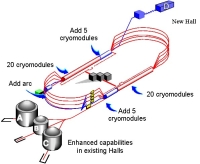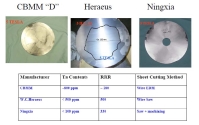Director’s Corner
16 October 2008
Progress and plans for ILC R&D at JLab
Jefferson Laboratory (JLab) in Newport News, Virginia, is a major DOE laboratory for Nuclear Physics. The laboratory has a pioneering 6-GeV electron accelerator that is based on superconducting radiofrequencey (RF) accelerating technology. JLab has a great deal of expertise, experience and facilities for superconducting RF technology, making them a natural and very important partner for our ILC R&D efforts. Along with our project managers, I visited JLab last month. We wanted to carry out dedicated and in-depth meetings with the JLab ILC researchers, in which we reviewed the present ILC work and explored the options for JLab’s future role in the ILC.
The centrepiece of Jefferson Laboratory is a 6-GeV accelerator for scattering experiments with electrons on nuclei. In the laboratory, they have also developed a free-electron laser Terahertz radiation experiment that generates a very bright beam, and they have carried out important feasibility studies on energy-recovery technologies that could lead to a new type of future particle accelerator.
A crucial early decision made at JLab in 1985 was to use superconducting RF accelerating technology for their 6-GeV electron accelerator. This became a kind of precursor to what we are planning for the main linac accelerator in the ILC. Construction of the Continuous Electron Beam Accelerator Facility (CEBAF) began in 1987; it was operational for science by the mid-1990s; and has carried out a comprehensive programme of electron scattering experiments off nuclei over the past decade.
They are now building on that success, by embarking on a major upgrade of the accelerator to 12 GeV. The upgrade will enable a new level of research at the higher energy and, in addition to doubling the accelerator beam energy, the project will include a new experimental hall and associated beamline as well as upgrades of the present experimental halls. In the course of the accelerator upgrade JLab will also add ten new 100-MV cryomodules of 19.2 MV/m continuous wave at Q > 8 109, as well as 13 kW continuous wave power couplers, new klystrons and low-level RF to provide the additional acceleration to 12 GeV.
JLab is central to our plans in the Americas toward our ambitious "S0" programme that aims to determine and demonstrate the cavity gradient for the ILC. In order to consistently produce high-gradient cavities, the JLab group is improving the manufacturing and processing of cavities, cleaning and assembly practices; optimising the electropolishing, using temperature maps to help locate quench faults and using high-resolution optical inspection techniques. The thermometry system that has been developed at JLab and became operational this year is being used in conjunction with optical inspection of hot spots and defects to understand thermal breakdown.
JLab is also doing more fundamental R&D on superconducting RF cavities, especially on materials such as large-grain and single-crystal cavities. Such alternatives could potentially be developed sufficiently by the time we are ready to begin ILC construction that they could be incorporated into the machine as built. This is just one example of how we plan to evolve the ILC design through our R&D programme. New improved cavities could be integrated in a straightforward way because of the plug compatible approach we are using.
It just so happened that Hugh Montgomery, or Mont, became the new Jefferson Laboratory Director the same week in early September that we visited the laboratory. Mont is very well known in high-energy physics through the steady hand he provided for many years in guiding the Fermilab research programme. We were pleased that he found the time to participate in many of our meetings last month. We look forward to working closely with him as our programme develops.
Also on behalf of my colleagues, I would like to congratulate Mont on his new position and wish him all the best in this new phase of his career. We are very confident that he will steer Jefferson Laboratory in exciting new ways, leading to a very productive future for the laboratory. We are hopeful that we will be a part of that future, as they partner with us on not only the development of the ILC technologies, but on the project itself.






















